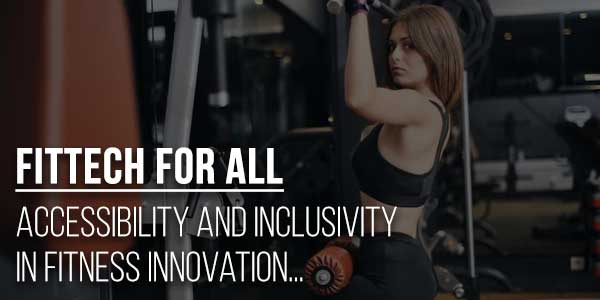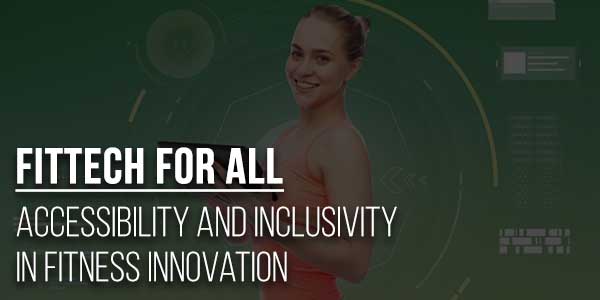
In recent years, the fitness industry has undergone a remarkable transformation, with technology playing a pivotal role in shaping the way we approach health and wellness. FitTech, a term that amalgamates fitness and technology, has emerged as a revolutionary force, providing individuals with innovative tools to enhance their fitness journey. However, as we revel in the advancements, it becomes crucial to address the issue of accessibility and inclusivity in fitness innovation. This blog delves into the evolving landscape of FitTech and explores how it can be harnessed to create a more inclusive and accessible fitness experience for everyone.
Table of Contents
The Evolution Of Fittech:
FitTech has witnessed unprecedented growth, fueled by a surge in wearable devices, mobile apps, and smart equipment. From fitness trackers monitoring our daily activities to virtual workout platforms bringing trainers to our living rooms, technology has reshaped the way we engage with our health. Amidst this technological revolution, fitness app development companies have played a crucial role in creating innovative solutions that cater to diverse user needs. Despite these strides, a significant portion of the population, particularly those with disabilities, has been left on the sidelines.
Understanding Accessibility In Fitness:
Accessibility in the context of fitness extends beyond physical spaces to encompass digital interfaces, equipment design, and the overall user experience. For individuals with disabilities, the barriers to entry into the fitness world can be multifaceted. Challenges may include navigating inaccessible websites, operating fitness equipment, or accessing adaptive workout programs. It is imperative that the FitTech industry acknowledges these hurdles and works towards breaking down these barriers.
1.) Adaptive Equipment And Inclusive Design:
One of the primary steps towards creating an inclusive fitness environment is the development of adaptive equipment and inclusive design. Traditional gym equipment is often not designed with accessibility in mind, making it challenging for individuals with disabilities to engage in a full range of exercises. FitTech companies can play a pivotal role in this regard by investing in the research and development of equipment that accommodates a diverse range of abilities.
For example, smart resistance machines with adjustable settings, voice-activated controls, and tactile feedback can empower individuals with mobility limitations to engage in strength training. Additionally, virtual reality (VR) and augmented reality (AR) can be integrated into workout experiences, providing a more immersive and accessible environment for users with various abilities.
2.) Accessible Digital Platforms:
In an era dominated by digital fitness platforms, ensuring accessibility online is paramount. Websites and mobile applications should adhere to accessibility standards, making them compatible with screen readers, voice commands, and other assistive technologies. Furthermore, fitness apps must offer customizable interfaces, allowing users to adapt the platform to their unique needs.
Inclusive fitness apps can go beyond conventional workout routines, offering adaptive programs that cater to different abilities. Whether it’s seated workouts, low-impact exercises, or specialized routines for specific conditions, a diverse range of options ensures that everyone can find a fitness plan that suits their needs.

3.) Personalized Fitness For All:
FitTech has the potential to revolutionize personalization in fitness, tailoring workouts to individual needs, preferences, and abilities. Machine learning algorithms can analyze user data, considering factors such as fitness level, health conditions, and personal goals to generate customized workout plans. This approach not only enhances the effectiveness of workouts but also ensures that individuals with varying abilities can participate in fitness activities catered to their specific needs.
Moreover, personalization extends beyond workout routines to user interfaces. FitTech should offer customization options that allow users to adapt the interface to their preferred modes of interaction, whether it’s touch, voice, or gesture controls. This level of personalization fosters a sense of inclusivity, acknowledging and accommodating diverse user needs.
4.) Virtual Reality And Inclusive Fitness Experiences:
Virtual reality (VR) holds immense potential in making fitness more inclusive. VR workouts can simulate a variety of environments, offering users a chance to engage in physical activities that might be challenging or impossible in their real-world surroundings. For individuals with mobility limitations, VR can provide an avenue for immersive and enjoyable fitness experiences.
In addition to simulating environments, VR can facilitate virtual group workouts, creating a sense of community for users who might be unable to attend in-person fitness classes. This virtual inclusivity ensures that individuals of all abilities can participate in group activities, fostering a supportive and motivating environment.
Challenges And Opportunities:
While FitTech holds the promise of a more inclusive and accessible fitness landscape, challenges persist. One major hurdle is the cost associated with adaptive equipment and technologies. FitTech companies must work towards making their products affordable and available to a broader audience, ensuring that inclusivity is not restricted by financial constraints.
Furthermore, education and awareness play a crucial role in promoting inclusivity. Fitness professionals, technology developers, and healthcare providers need to collaborate to bridge the knowledge gap and advocate for the benefits of accessible FitTech solutions. This collaboration can lead to the development of more targeted and effective fitness interventions for individuals with disabilities.
The Role Of Regulations:
Governments and regulatory bodies can also contribute to fostering inclusivity in FitTech by implementing and enforcing accessibility standards. Mandating that fitness equipment, apps, and websites adhere to specific accessibility guidelines can set a benchmark for the industry, encouraging innovation that is inclusive by design.
Conclusion:
As FitTech continues to redefine the fitness landscape, it is imperative to ensure that innovation is not limited to a select demographic. The journey towards a more inclusive and accessible fitness experience requires collaboration, innovation, and a commitment to breaking down barriers. FitTech has the potential to empower individuals of all abilities, making health and wellness a truly universal pursuit. By prioritizing accessibility in design, embracing adaptive technologies, and advocating for inclusive practices, the FitTech industry can lead the way toward a future where fitness truly is for all.

 About the Author:
About the Author:
















Be the first to write a comment.